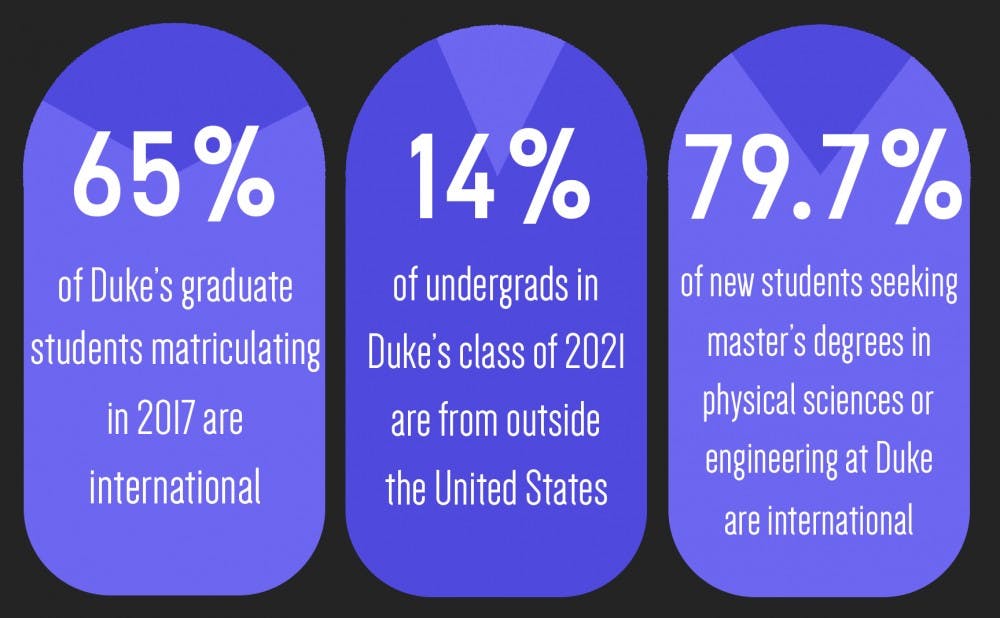Graduate schools nationwide have seen a rise of international students in STEM programs, and that trend is no different at Duke.
A recent article in The New York Times noted that within New York University’s Tandon School of Engineering, 80 percent of undergraduate students are U.S. residents while approximately 80 percent of graduate students are international. Although NYU is a particularly stark example, the article pointed out that about 55 percent of all U.S. graduate students in mathematics, computer sciences and engineering are international.
In Duke’s undergraduate class of 2021, 86 percent of the students hail from the United States. The Graduate School, by comparison, reported that just 35 percent of the students who matriculated in 2017 are domestic students.
The percentage of newly matriculated international students at the Graduate School who are seeking master’s degrees in the physical sciences or engineering is 79.7 percent, almost matching the percentage at NYU.
"Within our current overall enrollment, we have international students from 90 countries," wrote John Zhu, senior public affairs officer and communications strategist at The Graduate School, in an email. "Among students who entered in Fall 2017, we have international students from 52 countries."
The domestic-to-international graduate student ratio in recent years has not always favored international students. In 2009, the makeup of Duke’s newly-matriculated graduate student class was 50.2 percent domestic, tipping the scale towards domestic students by less than one percentage point.
Duke’s graduate program overall had more domestic than international students until 2013, when 51 percent of the school was international. International students have outnumbered domestic students each year since.
For physical sciences and engineering graduate programs, however, international students have outnumbered domestic enrollees for a longer period. In 2008, 62.7 percent of students in the science and engineering fields were international. That percentage has grown since.
One of the explanations the Times report offered for the dearth of domestic students in graduate STEM programs is that Americans don't see the need for advanced degrees because of the booming U.S. job market in technology.
The Times article also states that when more international students apply, schools do not have to provide as much tuition assistance. At Duke, however, Zhu explained that doctoral students receive the same packages regardless of whether they are domestic or international.
"The standard guaranteed Ph.D. financial support package from the Graduate School includes tuition coverage for students’ first five years of study," Zhu wrote.
He also noted that they can receive funding through the sixth year from the school if they can show that they applied for outside funding. While master’s degree students are not eligible for federal financial aid, they are still eligible for departmental scholarships, he said.
For overall international enrollment in the Graduate School this year, the top five foreign countries students came from were China, India, the Republic of Korea, Canada and Italy. Overall, this year's class represents 52 countries, while the overall enrollment of the school includes students from 90 countries.
The Graduate School has significantly more students from China than any other country outside of the United States, Zhu noted.
Shaoqing Ge, a fourth year Ph.D. student in the School of Nursing and director of academic programming for the Graduate and Professional Student Council, came to Duke from China.
Ge said several people who left China to study in the United States told her about the prospect of studying in the United States—which she says has one of the best education systems in the world.
“No offense to my homeland country, but the United States is one of the most powerful countries in the world,” Ge said. “I wanted to study here and then see if I could get the chance to stay and maybe make a better living in this country than in my homeland.”
Despite the general increase in recent years of international graduate students in STEM programs, the Times article noted that some engineering schools have seen a decline in international applications this semester. The Thayer School of Engineering at Dartmouth, for example, has seen 30 percent decrease in international applications within its professional master’s program.
The Times article explained that this recent decline could be a result of President Donald Trump’s attempts to ban the immigration of people from certain Muslim-majority countries, as well as Trump's other negative rhetoric about immigration.
A new contributing factor to the disparity between international and domestic graduate students could stem from recent proposed changes to the tax status of graduate school tuition that could have financial consequences for graduate students.
Get The Chronicle straight to your inbox
Sign up for our weekly newsletter. Cancel at any time.
On Wednesday, graduate students participated in a walk-out protesting the proposed Congressional bill. However, on Friday, the bill was passed through the Senate.
In the meantime, the University is not yet able to say whether its experienced a drop in international applicants this year. Zhu said Duke's graduate program application periods do not end until December, which is when the majority of the applications are received.
However, this has not stopped current graduate students at Duke from noticing a change.
Ge has also worked as a campus orientation peer for the International House and has represented international student interests at various advocacy events in Washington. She said Trump’s past comments about increasing the yearly income minimum to qualify for an H1B visa and his attempts to ban immigration from some Muslim-majority countries have created a climate that is unwelcoming for foreign students.

